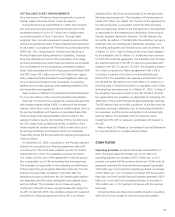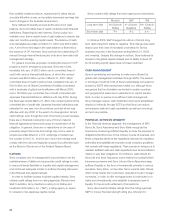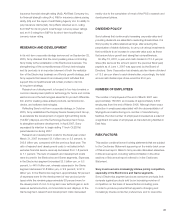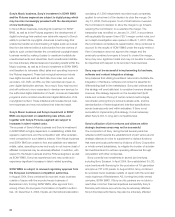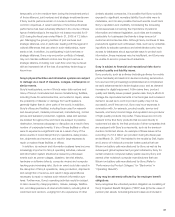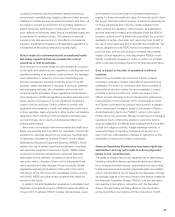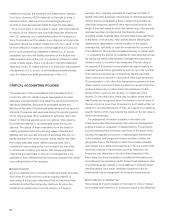Sony 2007 Annual Report Download - page 89
Download and view the complete annual report
Please find page 89 of the 2007 Sony annual report below. You can navigate through the pages in the report by either clicking on the pages listed below, or by using the keyword search tool below to find specific information within the annual report.86
Sony’s Music business, Sony’s investment in SONY BMG
and the Pictures segment are subject to digital piracy, which
may become increasingly prevalent with the development
of new technologies.
In Sony’s Music business, including its investment in SONY
BMG, as well as in the Pictures segment, the development of
digital technology has created new risks with respect to Sony’s
ability to protect its copyrights. Advances in technology that
enable the transfer and downloading of digital audio and visual
files from the Internet without authorization from the owners of
rights to such content threaten the conventional copyright-based
business model by making it easier to create and redistribute
unauthorized audio and visual files. Such unauthorized distribu-
tion has adversely affected sales and operating results within the
Music business, as well as in Sony’s investment in SONY BMG,
and threatens to adversely affect sales and operating income in
the Pictures segment. These technological advances include
new digital devices such as hard disk drive video and audio
recorders, CD, DVD, and Blu-ray Disc recorders and peer-to-
peer digital distribution services. As a result, Sony has incurred
and will continue to incur expenses to develop new services for
the authorized digital distribution of music, movies and television
programs and to combat unauthorized digital distribution of its
copyrighted content. These initiatives will increase Sony’s near-
term expenses and may not achieve their intended result.
Sony’s Music business and Sony’s investment in SONY
BMG are dependent on establishing new artists, and
together with Sony’s Pictures segment are subject to
increases in talent-related costs.
The success of Sony’s Music business and Sony’s investment
in SONY BMG is highly dependent on establishing artists that
appeal to customers, and the competition with other entertain-
ment companies for such talent is intense. If the Music business
and SONY BMG are unable to find and establish new talented
artists, sales, operating income and equity in net income (loss) of
affiliated companies may be adversely affected. In addition, with
respect to the Music business and the Pictures segment, as well
as SONY BMG, Sony has experienced and may continue to
experience significant increases in talent-related spending.
SONY BMG is subject to renewed regulatory approval from
the European Commission competition authorities.
In August 2004, Sony combined its recorded music business
outside of Japan with the recorded music business of
Bertelsmann AG, forming SONY BMG, after approval from,
among others, the European Commission competition authori-
ties. On December 3, 2004, Impala, an international association
consisting of 2,500 independent recorded music companies,
applied for annulment of the decision to clear the merger. On
July 13, 2006, the European Court of First Instance overruled
the Commission’s decision to allow the merger to go forward,
requiring the Commission to re-examine the merger. The
transaction was renotified on January 31, 2007, in accordance
with applicable European Union (“EU”) merger control rules, and
an in-depth investigation was opened on March 1, 2007. While
the Commission completes its reexamination, Sony continues to
account for the results of SONY BMG under the equity method.
If the Commission does not approve the merger and the
previously combined company is forced to unwind the merger,
Sony may incur significant costs and may not be able to achieve
its objectives with respect to its recorded music business.
Sony may not be successful in implementing its hardware,
software and content integration strategy.
Sony believes that utilizing broadband networks to facilitate the
integration of hardware, software and content is essential for
differentiating itself in the marketplace. Sony also believes that
this strategy will eventually lead to consistent revenue streams.
However, this strategy depends on the development (both
inside and outside of Sony) of certain network technologies,
coordination among Sony’s various business units, and the
standardization of technological and interface specifications
across business units and within industries. If Sony is not
successful in implementing this strategy, it could adversely
affect Sony’s mid- to long-term competitiveness.
Sony’s utilization of joint ventures and alliances within
strategic business areas may not be successful.
The composition of Sony during the last several years has
reflected a shift towards the establishment of joint ventures and
strategic alliances in order to supplement or replace functions
that were previously performed by divisions of Sony Corporation
or wholly-owned subsidiaries, to mitigate the burden of substan-
tial investments and to achieve operating efficiencies through
cooperation with other companies.
Sony currently has investments in several joint ventures,
including Sony Ericsson. In April 2004, Sony established S-LCD,
a joint venture with Samsung for the production of 7th generation
amorphous TFT LCD panels. In August 2004, Sony combined
its recorded music business outside of Japan with the recorded
music business of Bertelsmann AG, forming the jointly-owned
company, SONY BMG. If Sony and its partners are not able to
reach their common financial objectives successfully, Sony’s
financial performance as a whole may be adversely affected.
Sony’s financial performance may also be adversely affected



